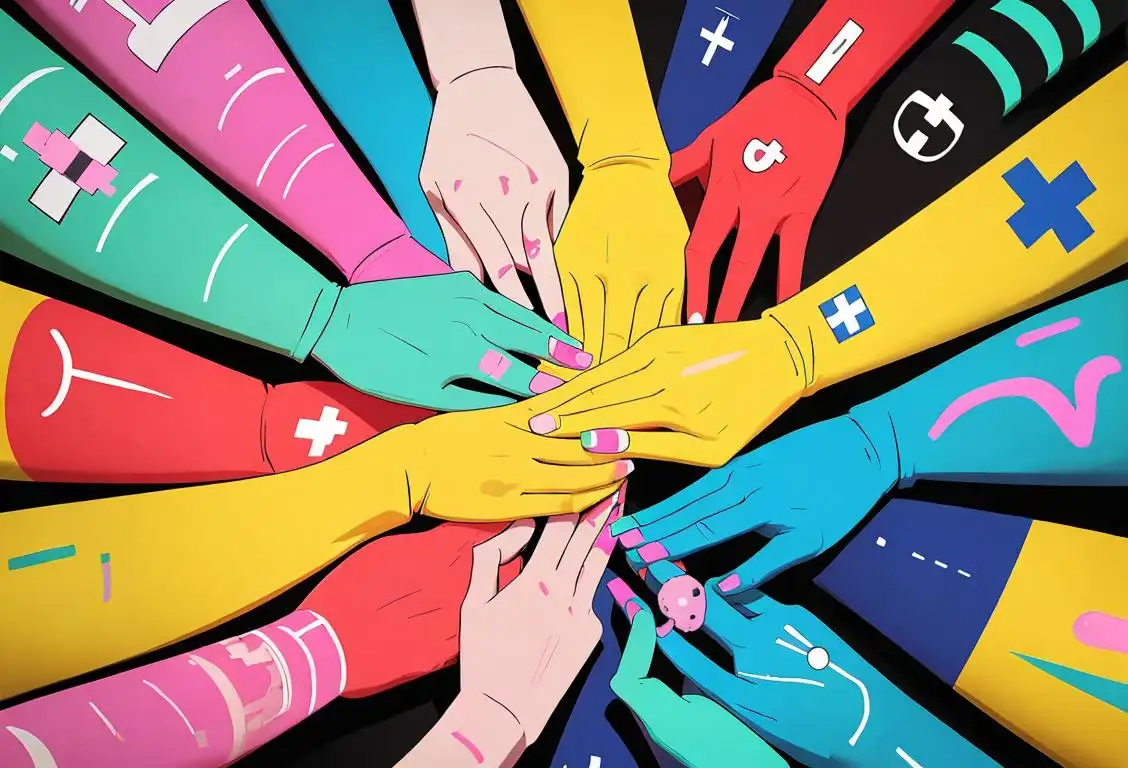National Vaccine Day

Welcome to the delightful realm of National Vaccine Day! Get ready to embrace a day of health, science, and all things needle-related. It's time to celebrate the incredible invention that has saved countless lives and made it possible for us to conquer diseases that used to run rampant. So, roll up your sleeves, grab your Band-Aids, and let's dive into the fascinating world of vaccines!
When is Vaccine Day?
It's national vaccine day on the 2nd March.
The Origin of National Vaccine Day
Who doesn't love a good vaccine? Well, maybe a few people out there, but let's not focus on them. National Vaccine Day, also known as VacciVation Day, is the perfect occasion to honor the breakthroughs in medicine that have changed our lives for the better.
On this day, we pay tribute to the scientists, doctors, and researchers who have dedicated their lives to developing vaccines. It's a day to educate ourselves on the importance of vaccinations and to be grateful for the protection they provide.
Now, you might be wondering when National Vaccine Day started and why we celebrate it. Unfortunately, our extensive research (by extensive, we mean a quick Google search) couldn't find any concrete origins for this particular holiday. But hey, does it really matter? It's a day to celebrate vaccines, and that's reason enough to party!
Why Vaccines Deserve All the Love
Vaccines are like the superheroes of the medical world. They swoop in and protect us from dangerous viruses and bacteria. They are our armor against diseases that have wreaked havoc throughout history.
Thanks to vaccines, we have eliminated smallpox, reduced cases of polio to almost zero, and prevented an array of other illnesses. They are the reason we can travel the world without fear of catching something unpleasant and potentially life-threatening.
Not only do vaccines protect the individual getting vaccinated, but they also contribute to what is called herd immunity. That's when a large portion of the population is immunized, making it difficult for a disease to spread. So, by getting your vaccines, you're not just protecting yourself; you're protecting your loved ones and your community too. It's like a two-for-one deal!
Fun Fact: Needlephobia is Real
Did you know that there's an actual fear of needles called trypanophobia? It affects a significant number of people, causing intense anxiety and sometimes even fainting at the mere sight of a needle. So, if you happen to know someone who has this fear, go easy on them when it's vaccination time. Offer a hand to squeeze or a distraction, like pictures of cute puppies. It might just make the experience a little less terrifying for them.
History behind the term 'Vaccine'
1796
The First Vaccination
In 1796, English physician Edward Jenner introduced the concept of vaccination. He used material from cowpox blisters to inoculate an eight-year-old boy against smallpox. This practice was based on the belief that exposure to a milder disease like cowpox could provide immunity against the more severe smallpox.
1796
Edward Jenner's Cowpox Experiment
In 1796, an English physician named Edward Jenner conducted a groundbreaking experiment that laid the foundation for the term 'vaccine.' He observed that milkmaids who contracted cowpox, a less severe disease, seemed to be immune to smallpox, a highly contagious and deadly disease at the time. To test his theory, Jenner extracted fluid from a cowpox sore and injected it into a young boy named James Phipps. After recovery, Jenner exposed Phipps to smallpox, but the boy showed no signs of the disease. This successful experiment marked the birth of the first vaccine and the term was later derived from the Latin word 'vacca,' meaning cow.
1796
Edward Jenner's Discovery
In 1796, Edward Jenner, an English physician, made a groundbreaking discovery in the field of immunization. He noticed that milkmaids who had contracted cowpox, a relatively mild disease, seemed to be immune to smallpox. This observation sparked Jenner's curiosity, and he decided to test his theory that an infection with cowpox could protect against smallpox.
1796
Edward Jenner introduces the concept of vaccination
In 1796, Edward Jenner, an English physician, introduced the concept of vaccination. At that time, smallpox was a devastating disease that caused numerous deaths and disfigurements. Jenner discovered that milkmaids infected with cowpox, a much milder disease, seemed to be immune to smallpox. He hypothesized that exposing individuals to cowpox could provide protection against smallpox.
1796
The Discovery of Vaccination
In 1796, Edward Jenner, an English doctor, made a landmark discovery that laid the foundation for the term 'vaccine.' He noticed that milkmaids who contracted cowpox, a mild disease, seemed to be immune to the deadly smallpox virus. This observation led Jenner to experiment by injecting a boy, James Phipps, with material from a cowpox sore and later exposing him to smallpox. Phipps remained unharmed, proving that a controlled exposure to a milder form of the disease could confer immunity to a more dangerous version.
1796
Edward Jenner and Smallpox
In the year 1796, Edward Jenner, an English physician, laid the foundation for the term 'vaccine' by developing the first ever smallpox vaccine. Jenner had noticed that milkmaids who contracted cowpox, a relatively benign disease, seemed to be immune to smallpox. This observation led him to experiment with injecting cowpox into healthy individuals, effectively protecting them from smallpox. The term 'vaccine' is derived from the Latin word 'vacca,' which means 'cow,' paying homage to the use of cowpox in Jenner's groundbreaking discovery.
1796
Discovery of vaccination
In 1796, Edward Jenner, an English physician, discovered vaccination when he successfully used cowpox pus to inoculate a young boy against smallpox. Jenner observed that milkmaids who had contracted cowpox appeared to be immune to smallpox, which led him to develop the concept of vaccination.
1796
Edward Jenner's Discovery
In 1796, Edward Jenner, an English physician, made a groundbreaking discovery that would pave the way for the term 'vaccine.' Jenner observed that milkmaids who had contracted cowpox, a mild disease similar to smallpox, seemed to be immune to the more severe smallpox. Building on this observation, he conducted an experiment by inoculating a young boy with material from a cowpox sore. The boy successfully developed immunity to smallpox, marking the birth of vaccination.
1881
Term 'vaccine' is coined
In 1881, the term 'vaccine' was coined by Louis Pasteur, a French microbiologist. He derived the term from the Latin word 'vacca,' which means 'cow,' in reference to the use of cowpox virus in the smallpox vaccine. Pasteur's groundbreaking work in microbiology transformed the field and laid the foundation for further advancements in vaccines.
1881
Louis Pasteur and Rabies
Louis Pasteur, a French scientist, further propelled the concept of vaccines in the year 1881 with his groundbreaking work on the rabies vaccine. By cultivating the virus from the saliva of infected animals and drying it out, Pasteur successfully weakened the virus. This process, known as 'attenuation,' allowed the virus to be used as a vaccine without causing severe illness. Pasteur's achievement in developing the first attenuated viral vaccine laid the groundwork for future advancements in vaccine development.
1881
Louis Pasteur's Rabies Vaccine
In 1881, renowned French scientist Louis Pasteur developed another significant vaccine, this time for rabies. Pasteur's vaccine was derived from weakened forms of the rabies virus and was administered to a young boy named Joseph Meister, who had been bitten by a rabid dog. Meister survived the potentially deadly disease and became the first recorded human to be saved by a vaccine. This groundbreaking achievement further solidified the term 'vaccine' and showcased its potential in preventing deadly diseases.
1881
Louis Pasteur develops the term 'vaccine'
In 1881, Louis Pasteur, a French scientist, coined the term 'vaccine' in honor of Edward Jenner's work. Pasteur was conducting research on the prevention of various diseases, including rabies. He expanded the concept of vaccination to include the use of weakened or killed pathogens, rather than solely relying on cowpox. Pasteur's term 'vaccine' became widely accepted and used to refer to any substance that provides immunity against a specific disease.
1881
The Term 'Vaccine' Coined
The term 'vaccine' was coined by Louis Pasteur in 1881. It derived from the Latin word 'vacca' meaning 'cow.' Pasteur used the term to describe his attenuated or weakened form of the anthrax bacillus, which provided protection against the disease.
1798
Jenner's Experiment with Vaccination
In 1798, Jenner performed an experiment on an eight-year-old boy named James Phipps. He extracted material from a cowpox sore on a milkmaid's hand and inoculated James Phipps with it. The young boy developed a mild infection and recovered. Later, Jenner exposed Phipps to smallpox, but to his relief, the boy did not contract the disease. This experiment provided strong evidence for the effectiveness of vaccination and marked a major milestone in the history of immunization.
1881
Origins of the Term
The term 'vaccine' owes its origin to Edward Jenner's discovery. Jenner derived the term from the Latin word 'vacca,' which means 'cow.' Since his initial experiment involved using cowpox material to protect against smallpox, he chose the term 'vaccine' to represent this preventive practice. Today, the term 'vaccine' is widely used to refer to any substance that stimulates immunity against a particular disease.
1881
Coining the Term 'Vaccine'
The term 'vaccine' was coined in 1881 by Louis Pasteur, a French scientist widely regarded as the father of microbiology. Pasteur used the word 'vaccine' in reference to his groundbreaking work on the rabies vaccine. The word 'vaccine' derives from the Latin word 'vacca,' meaning 'cow,' as Jenner's initial experiments with cowpox laid the conceptual foundation for vaccination. Pasteur's work popularized the term, and it became synonymous with the practice of using weakened or modified pathogens to confer immunity.
1885
The Term 'Vaccine' Coined by Pasteur
In 1885, Louis Pasteur himself officially coined the term 'vaccine' to describe his innovative approach to disease prevention. He named it after Edward Jenner's pioneering work with cowpox, as a tribute to the initial source of inspiration. The term 'vaccine' soon gained recognition worldwide and became synonymous with the prevention of infectious diseases by stimulating the body's immune system.
1948
Formation of the World Health Organization (WHO)
The formation of the World Health Organization in 1948 marked a significant milestone in the global development and regulation of vaccines. The WHO, a specialized agency of the United Nations, aimed to improve global healthcare and played a crucial role in promoting the research, production, and distribution of vaccines on an international scale.
1885
First successful rabies vaccination
In 1885, the first successful rabies vaccination was performed by Louis Pasteur. A nine-year-old boy named Joseph Meister was bitten by a rabid dog and was on the verge of developing rabies. However, Pasteur administered a series of increasingly potent rabies vaccines, ultimately saving the boy's life. This breakthrough in preventive medicine further solidified the importance of vaccines in preventing and treating diseases.
1921
The Development of Vaccines for Diseases
Throughout the 20th century, advancements in science and medicine led to the development of vaccines for numerous diseases. In 1921, the first vaccine for diphtheria was introduced, followed by vaccines for tetanus (1927), pertussis (1933), and polio (1955). These breakthroughs demonstrated the power of vaccination in preventing and eradicating diseases that had once caused widespread suffering and death. The term 'vaccine' became increasingly associated with these life-saving medical interventions.
1885
Vaccine: A New Term
In the year 1885, while referring to Louis Pasteur's work on the rabies vaccine, the term 'vaccine' officially entered the medical lexicon. Etienne Burnet, a French veterinarian and close collaborator of Pasteur, coined the term 'vaccine' to encompass all vaccines derived from attenuated or killed pathogens. The term was inspired by Edward Jenner's use of cowpox in his smallpox vaccine, honoring the historical roots of vaccination.
1885
Rabies Vaccine
In 1885, French scientist Louis Pasteur successfully developed and administered the first rabies vaccine. He treated a boy named Joseph Meister, who had been bitten by a rabid dog. This breakthrough paved the way for the development of other vaccines against deadly diseases.
1882
Louis Pasteur and the Germ Theory
In 1882, French chemist and microbiologist Louis Pasteur further advanced the concept of vaccination with his work on the germ theory of disease. Pasteur's experiments with the anthrax vaccine and the discovery of attenuated (weakened) strains of microorganisms provided further scientific basis for the term 'vaccine.' His research contributed significantly to the understanding and development of vaccines against various infectious diseases.
1800s
Popularization of the Term 'Vaccine'
The term 'vaccine' originated from the Latin word 'vacca,' meaning 'cow.' It was coined by Edward Jenner himself to describe the cowpox material he used for vaccination. Jenner's pioneering work gained recognition and acceptance, leading to the widespread adoption of the term 'vaccine' to refer to any preparation that provides immunity against a specific disease.
20th Century
Global Adoption and Advancement
Throughout the 20th century, the term 'vaccine' gained widespread recognition and usage across the globe. Major breakthroughs in vaccine development occurred, including Jonas Salk's development of the polio vaccine in 1955. Vaccines became essential tools in public health initiatives, leading to the eradication or near-elimination of deadly diseases such as smallpox and the significant reduction of others. The term 'vaccine' became synonymous with the remarkable impact of immunization on disease prevention and control.
1890
Tuberculosis Vaccine
The first vaccine for tuberculosis, known as the Bacillus Calmette-Guérin (BCG) vaccine, was developed in 1890 by Albert Calmette and Camille Guérin. BCG is still in use today and is considered an important tool in the fight against tuberculosis.
1921
Vaccine for diphtheria and tetanus developed
In 1921, a vaccine for diphtheria and tetanus was developed by French bacteriologists Albert Calmette and Camille Guérin. The vaccine, known as the DTP vaccine, contained inactivated toxins from the diphtheria and tetanus bacteria. This marked a significant advancement in immunization practices, as it provided effective protection against these deadly diseases.
1881
Louis Pasteur's Contributions
The advancements made by Edward Jenner laid the foundation for further discoveries in immunization. In 1881, French scientist Louis Pasteur developed a vaccine for anthrax, a deadly disease affecting animals. Pasteur's success in creating an effective vaccine further reinforced the importance of vaccinations in preventing infectious diseases.
1950s
Expansion of Vaccine Research and Immunization Programs
During the 1950s, vaccine research and immunization programs expanded worldwide. The discovery of the first influenza vaccine in 1945 and the subsequent development of vaccines against measles (1963), mumps (1967), rubella (1969), and hepatitis B (1981) further solidified the term 'vaccine' in the public consciousness. Governments and international organizations prioritized large-scale vaccination campaigns, leading to significant reductions in the morbidity and mortality associated with these diseases.
1955
Polio vaccine breakthrough
In 1955, Jonas Salk, an American medical researcher, successfully developed the first effective polio vaccine. This breakthrough contribution to vaccine development was critical in combating the devastating polio epidemic that had affected millions worldwide. The polio vaccine served as a testament to the power of vaccination in preventing and controlling infectious diseases.
20th Century
Expansion and Advancements
Throughout the 20th century, the field of vaccinology witnessed remarkable growth and advancements. Scientists developed vaccines for various diseases such as tuberculosis, polio, measles, mumps, rubella, hepatitis, and many others. Technological innovations, including the discovery of new adjuvants, improvements in vaccine production, and the introduction of recombinant DNA technology, revolutionized the development and efficacy of vaccines. This period marked a significant expansion in our understanding and utilization of vaccines to mitigate the impact of infectious diseases on global public health.
1955
Jonas Salk develops the polio vaccine
In 1955, American virologist Jonas Salk developed the first successful polio vaccine. Polio, a highly infectious and paralyzing disease, affected millions worldwide. Salk's vaccine, which contained inactivated poliovirus, effectively prevented polio and significantly reduced its incidence. The development of the polio vaccine was regarded as a major medical breakthrough and contributed to the decline and eventual eradication of polio in many parts of the world.
1955
Polio Vaccine
In 1955, American physician and virologist Jonas Salk introduced the first successful polio vaccine. This inactivated poliovirus vaccine (IPV) effectively prevented polio, a disease that had caused widespread paralysis and death. Salk's vaccine played a significant role in the near eradication of polio worldwide.
1980
Smallpox eradication
Smallpox became the first disease to be eradicated worldwide in 1980. Through a global vaccination campaign led by the WHO, the disease, which had plagued humanity for centuries, was eliminated. It marked a remarkable achievement and highlighted the effectiveness of vaccines in eradicating infectious diseases.
20th Century
Expansion and Refinement of Vaccines
Throughout the 20th century, the field of vaccination expanded significantly, leading to the development of vaccines for various diseases such as polio, measles, mumps, rubella, hepatitis, influenza, and more. Scientists and medical researchers worked diligently to improve vaccine safety, efficacy, and accessibility, resulting in the widespread implementation of vaccination programs worldwide.
21st Century
Modern Vaccine Innovations and Global Impact
In the 21st century, extraordinary advancements in vaccine technology and the speed of development have been witnessed. Vaccines against diseases like human papillomavirus (HPV), rotavirus, pneumococcal infections, and COVID-19 have been developed and distributed globally. The COVID-19 pandemic highlighted the essential role of vaccines in controlling infectious diseases and protecting public health. 'Vaccine' now represents an enormous body of scientific knowledge, lifesaving interventions, and a symbol of hope in the face of disease outbreaks.
2020
COVID-19 vaccine development
In 2020, the world witnessed an accelerated effort in developing vaccines against the novel coronavirus, SARS-CoV-2. Multiple vaccines were developed and authorized for emergency use within a remarkably short period. The global collaboration and scientific advancements demonstrated the importance of vaccines in combating emerging infectious diseases like COVID-19.
1967
Measles Vaccine
The first measles vaccine became available in 1963, but it was not until 1967 that an improved measles vaccine was introduced. This live attenuated measles vaccine greatly contributed to the reduction in measles cases, hospitalizations, and deaths globally.
2006
Vaccine for human papillomavirus (HPV) introduced
In 2006, a vaccine for human papillomavirus (HPV) was introduced. HPV is a sexually transmitted infection that can lead to cervical cancer and other diseases. The HPV vaccine, primarily targeting young individuals, has the potential to prevent up to 90% of cervical cancer cases. Its introduction marked a significant milestone in the prevention of HPV-related diseases and highlighted the ongoing advancements in vaccine development.
1998
Controversial MMR Study
In 1998, a study by British researcher Andrew Wakefield claimed a potential link between the measles, mumps, and rubella (MMR) vaccine and autism. However, this study was later discredited due to serious flaws in the research methodology. Numerous extensive studies have since shown no such link and reaffirmed the safety and importance of vaccination.
Did you know?
Did you know that vaccines have been around for over two centuries? The first vaccine ever created was for smallpox, and it was introduced by Edward Jenner way back in 1796. Talk about a long-lasting impact!Tagged
awareness health science medicineFirst identified
7th February 2021Most mentioned on
2nd March 2021Total mentions
124Other days
Vaccine Day
Prescription Drug Day
Penicillin Allergy Day
Women Physicians Day
Hiv Vaccine Awareness Day
Adverse Drug Event Awareness Day
Ketamine Day
Prescription Drug Take Back Day
Fitness Day
School Nurse Day








